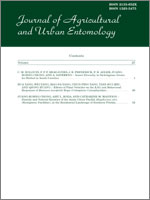Noctuid moths possess tympanal hearing organs capable of detecting ultrasonic echolocation calls of hunting bats, which leads to the supposition that ultrasound may be an environmental stress factor for these insects. Effects of non-bat ultrasound from a commercial ultrasound-producing device, LCH20 (Lihui, Inc., Wuhan, China), on the fecundity of adult Helicoverpa armigera (Hübner) (Lepidoptera: Noctuidae) were investigated in the laboratory. In each of the three trials, 10 newly emerged pairs of male and female moths were introduced into cages with or without added ultrasound. The ultrasound device produced frequencies between 33 and 69 kHz and a 97 dB sound pressure level at a distance of 50 cm. In the cage with ultrasound, female moths had 11.7% more spermatophores and produced 54.5% more eggs than those not exposed to ultrasound. There were no differences between the daily development patterns of larval H. armigera in the absence or presence of ultrasound, however the pupation rate was reduced by 14.5% in the presence of ultrasound. This is the first report that ultrasound affects the mating, oviposition, and development in H. armigera.
BioOne.org will be down briefly for maintenance on 17 December 2024 between 18:00-22:00 Pacific Time US. We apologize for any inconvenience.
How to translate text using browser tools
1 January 2013
Effects of Ultrasound on the Fecundity and Development of the Cotton Bollworm, Helicoverpa armigera (Hübner) (Lepidoptera: Noctuidae)
Yu-Ping Zha,
Jing-Yuan Chen,
Zhan-Bao Jin,
Cheng-Bin Wang,
Chao-Liang Lei
ACCESS THE FULL ARTICLE
It is not available for individual sale.
This article is only available to subscribers.
It is not available for individual sale.
It is not available for individual sale.
development
fecundity
Helicoverpa armigera
Lepidoptera
ultrasound





